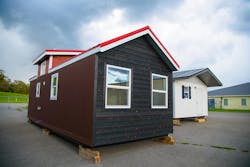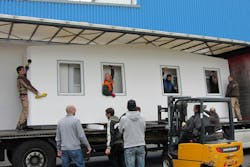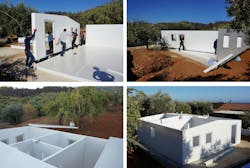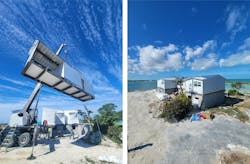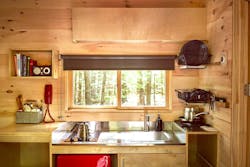Light But Tough: MDLR Brands’ Building Panels
The building panels manufactured by Tennessee-based MDLR Brands are so lightweight that just four people can carry a panel sheet measuring 8 by 32 feet.
“You couldn’t have four men carry an 8-by-32 wooden or metal SIP,” says Harrison Langley, CEO, MDLR (pronounced “modular”) Brands.
MDLR Brands’ composite SIPs (structural insulated panels) weigh in at just over 1 pound per square foot. As a result, builders don’t need forklifts or cranes to install them. Instead, a simple pulley system and a couple of workers can maneuver and place the panels onsite.
Benefits of LiteSIP Building Panels
That’s just one of the benefits delivered by MDLR Brands’ SIP, which the company calls LiteSIP. Here are several others Langley shared:
- LiteSIP is light but tough: The panels are durable enough to withstand earthquakes, fires, tornadoes, and Category 5 hurricanes, the company says. And unlike wood, they resist mold and termites.
- Because of LiteSIP’s light weight, the panels can span larger distances between structural beams. For instance, a 30-foot-wide room could have a vaulted ceiling made of LiteSIP with just one beam down the center—“and that would be the support for the entire roof,” Langley says. LiteSIP also gets rid of traditional truss systems—which is “huge,” he adds.
- In addition to a foam insulation core, LiteSIP has a fiberglass exterior whose manufacturing process avoids the volatile organic compounds (VOCs) that are traditionally associated with fiberglass.
- Because the insulated panels don’t contain metal components, they avoid thermal bridges. With enhanced insulation and energy efficiency, LiteSIP results in less reliance on heating and cooling systems and thus lower energy use throughout the building’s lifetime.
- The panels’ durable composite material minimizes ongoing maintenance and leads to a longer lifespan for the home, and the material performs equally well in hot and cold environments.
Building Modular Homes with Prefab Building Panels
Founded in 2019, MDLR Brands manufactures its panels in a factory that used to be located in Kentucky but is now in Brazil. The controlled factory environment results in greater efficiency and less waste, the company says. The prefab building panels are then assembled onsite, saving on labor and time compared to conventional methods. LiteSIP can be used in a range of structures—from accessory dwelling units (ADUs) to single-family homes to large commercial buildings.
But MDLR Brands doesn’t just make panels. As its name indicates, it’s also a modular builder. The factory manufacturing and onsite assembly enable faster construction, Langley says. MDLR Brands’ average turnaround time for its homes following the design phase is five to six months.
In the Bahamas, the company built a 2,400-sf modular home with 4 bedrooms and 3 bathrooms in just five weeks. “Normally it takes five to seven years to build something there, so we got a lot of attention when we did that build,” Langley says.
MDLR Brands’ durable panels are proving popular in the hurricane-prone islands, where the company has three more home projects lined up. Those modular units will be built at the company’s headquarters in Chattanooga, Tenn.
“A traditional stick-frame house doesn’t stand a chance [against Category 5 storms], and metal SIPs are too thin, so as soon as they’re bent, that gets rid of the whole structure,” Langley says. “Our SIPs are much more rigid.”
But in the US, demand has been stronger for MDLR Brands’ panels than for its modular homes, Langley says. “I don’t know if a market in the U.S. will want to pay the expense of modular homes,” Langley says. “That seems to be where our manufacturing is focused: sending units to the Bahamas but sending roofs and ADU shells to the U.S.”
With the company’s Boxvana line of modular, prefab homes, customers can customize their unit’s layout and finishes, as well as the appliances, porches, solar, and loft space. To date, MDLR Brands has completed 28 projects, some of them including multiple units.
The Boxvana line offers 15 models. These include a 320-sf ADU (accessory dwelling unit) starting at $25,000; a 160-sf towable RV with 1 bed and 1 bath, starting at $65,000; and a 1,400-sf single-family home with 3 beds and 2 baths, starting at $195,000. On the higher end, a 3,200-sf, 4-bed, 3.5-bath home goes for $1.2 million and up.
